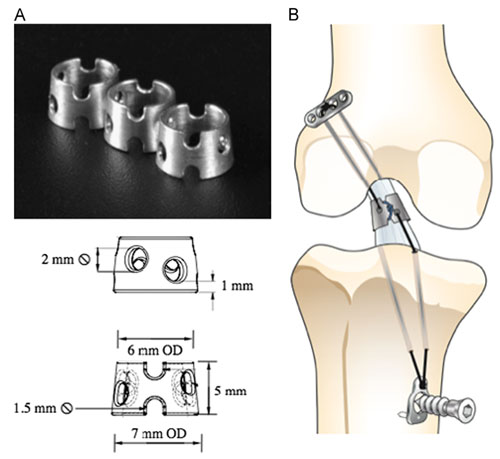
| Name: | Kathryn (Katie) Farraro |
| Title: | PhD Candidate |
405 Center for Bioengineering
300 Technology Drive
Pittsburgh, PA 15219
Phone: 412-648-1943
Fax: 412-648-2001
kff7@pitt.edu
- Anterior cruciate ligament (ACL) healing using bioresorbable metallic and extracellular matrix bioscaffolds
With the recent advances in functional tissue engineering, biological augmentation has been successfully used _to enhance the healing of a surgically transected ACL. However, these studies also found that the rate of healing was slow and mechanical augmentation would be required to maintain knee stability and facilitate the biological processes of ACL healing. To this end, we have designed a novel Mg-based ring to bridge the gap between the two torn ends of the ACL in order to serve as an internal splint as an alternative for mechanical augmentation (Fig. 1, Farraro, et al. 2013). The ring would degrade as the ACL healing progresses and bears more of the load. It is intended to be used alongside cells, cytokines, or bioscaffolds while releasing these biological agents on a timely basis in order to accelerate healing and remodeling.
In vitro testing on our robotic/UFS testing system using a cadaveric goat model has shown that Mg ring repair could restore knee kinematics to near-normal levels under externally applied loads mimicking those used in clinical examinations to test ACL function. Additionally, in-situ forces were returned to levels of the intact ACL. Current work includes evaluation of the advantages of using Mg ring repair alongside a urinary bladder matrix (UBM) bioscaffold and hydrogel to heal a surgically transected ACL at 12 weeks of healing in a goat model.

Fig. 1. (A) Photograph and schematic of the Mg-based ring and (B) a schematic diagram of Mg-based ring repair of the ACL.
Hobbies: Traveling, music, fashion, reading, hiking, cooking
Home Country: USA
Publications:
- Speziali A, Farraro KF, Kim KE, Woo SL-Y. Biological and Mechanical Augmentation for Healing of Ligaments and Tendons in 97th National Meeting SIOT 2012 Proceedings, Rome Italy, 38(2):26-30, 2012.
- Tei, M.M., Farraro, K.F., Woo, S.L-Y.: Ligament and Tendon Enthesis: Anatomy and Mechanics in Structural Interfaces and Attachments in Biology. Eds. Thomopoulos, Genin, and Birman, Springer-Verlag. In Press, July 2012.
- Farraro K, Kim K, Woo S L-Y. Flowers J, McCullough M. Revolutionizing Orthopaedic Biomaterials: The Potential of Biodegradable and Bioresorbable Magnesium-Based Materials for Functional Tissue Engineering. Journal of Biomechanics, 2013 December 26 [Epub ahead of print]
- Sasaki N, Farraro K, Kim K, Woo S L-Y. Biomechanical Evaluation of the Quadriceps Tendon Autograft for ACL Reconstruction: A Cadaveric Study. American Journal of Sports Medicine. 2014 January 28 [Epub ahead of print]
- Woo, S.L-Y., Farraro, K.F., Flowers, J.R., Chen, C.: Measuring In Vivo Joint Motion and Ligament Function - New Developments in Sports Injuries - Prevention, Diagnosis, Treatment and Rehabilitation, Second Edition. Eds. M.N. Doral and J. Karlsson, Springer-Verlag, Heidelberg, Germany, Submitted May 2014.
- Woo S.L-Y, Kim KE, Farraro KF. Orthopaedic Research in the Year 2025 in Sports Injuries - Prevention, Diagnosis, Treatment and Rehabilitation, Second Edition. Ed. MN Doral, Springer-Verlag, Heidelberg, Germany, Accepted, June 2014.
